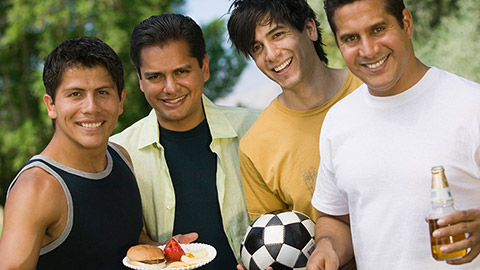Fraternal birth order linked to same-sex attraction in men

Several studies have found fraternal birth order to be a factor that influences the odds of a man being gay.
Gay men tend to have a greater number of older brothers compared to straight men, straight women, and gay women. This by no way means that a large number of older brothers guarantees that a boy will grow up to be gay—or that boys without older brothers will not be gay. Rather, having older brothers increases the odds of a man being gay. For instance from a 2% chance (no older brothers) to a 6% chance (4 older brothers).
How significant is the birth-order effect?
According to J. Michael Bailey, PhD (2016), and fellow researchers, the fraternal-birth-order effect is significant, “in the sense that it increases the odds of a man’s homosexuality appreciably. Assuming that a man without any older brothers has a 2% chance of being homosexual, a man with one older brother has a 2.6% chance; with two, three, and four older brothers, the chances are 3.5%, 4.6%, and 6.0%, respectively.” (Bailey et al., 2016 p. 79).
What about non-biological brothers?
Anthony F. Bogaert, PhD, has demonstrated that the fraternal-birth-order effect is only relevant for biological, as opposed to non-biological (such as adopted) older brothers, suggesting that it is prenatal in origin: “Only biological older brothers, and not any other sibling characteristic, including nonbiological older brothers, predicted men's sexual orientation, regardless of the amount of time reared with these siblings. These results strongly suggest a prenatal origin to the fraternal birth-order effect.” (Bogaert, 2006, Abstract).
Why would fraternal birth order influence the odds that a man would be gay?
Ray Blanchard, Ph.D.,Professor of Psychology at the University of Toronto, developed an intriguing theory, which has subsequently been supported by findings in numerous studies (Blanchard, et al., 2020).
Dr. Blanchard explains:
“It has been hypothesized that the fraternal birth order effect reflects the progressive immunization of some mothers to Y-linked minor histocompatibility antigens (H-Y antigens) by each succeeding male fetus and the concomitantly increasing effects of such maternal immunization on the future sexual orientation of each succeeding male fetus” (Blanchard, 2001, Abstract).
Dr. Blanchard and others have hypothesized that some mothers’ bodies develop antibodies in reaction to a male fetus, with the antibodies increasing with each successive (male) pregnancy. According to Dr. Blanchard’s hypothesis, these antibodies have the capacity to influence sexual differentiation in the fetal brain, leading to an increased incidence of same-sex attraction:
“[A]nti-H-Y antibodies produced by the mother pass through the placental barrier to the fetus and affect aspects of sexual differentiation in the fetal brain” (Blanchard, 2001, Abstract).
While Dr. Blanchard’s hypothesis is just that—a hypothesis—it has received a great deal of support in the scientific community because it is consistent with a variety of empirical evidence and has held up for more than two decades of research and study.
Dr. Blanchard notes:
“This explanation is consistent with a variety of evidence, including the apparent irrelevance of older sisters to the sexual orientation of later born males, the probable involvement of H-Y antigen in the development of sex-typical traits, and the detrimental effects of immunization of female mice to H-Y antigen on the reproductive performance of subsequent male offspring. The maternal immune hypothesis might also explain the recent finding that heterosexual males with older brothers weigh less at birth than heterosexual males with older sisters and homosexual males with older brothers weigh even less than heterosexual males with older brothers.” (Blanchard, 2001, Abstract)
References:
Bailey, J.M., Vasey, P.L., Diamond, L.M., Breedlove, S.M., Vilan, E. & Epprecht, M. (2016). Sexual orientation, controversy, and science. Psychological Science in the Public Interest, 17(2), 45-101. https://journals.sagepub.com/doi/pdf/10.1177/1529100616637616
Blanchard, R. (2001). Fraternal birth order and the maternal immune hypothesis of male homosexuality. Hormones and Behavior, 40(2), 105-114. https://doi.org/10.1006/hbeh.2001.1681
Blanchard, R. 2018. Fraternal birth order, family size, and male homosexuality: meta analysis of studies spanning 25 years. Arch Sex. Behav. 47 (1-15). https://link.springer.com/article/10.1007/s10508-017-1007-4
Blanchard, R., et al. (2020). A method yielding comparable estimates of the fraternal birth order and female fecundity effects in male homosexuality. Proceedings of the Royal Society B., 287 (1923). https://royalsocietypublishing.org/doi/10.1098/rspb.2019.2907
Bogaert, A.F. (2006). Biological versus nonbiological older brothers and men's sexual orientation. Proceedings of the National Academy of Sciences of the United States of America, 103(28), 10771-10774. doi:10.1073/pnas.0511152103
Dee
Who is Dee?
Gender Identity
 Our core sense of who we are as a man, a woman, a mixture of both, or neither.
Our core sense of who we are as a man, a woman, a mixture of both, or neither.
Gender Expression
 How we show up in the world through choices like clothing, hair style, mannerisms or tone of voice.
How we show up in the world through choices like clothing, hair style, mannerisms or tone of voice.
Attraction
 How we feel toward others sexually, romantically and/or emotionally.
How we feel toward others sexually, romantically and/or emotionally.
Biological Sex
 Physical attributes such as reproductive organs and genitalia, chromosomes, genes and hormone levels.
Physical attributes such as reproductive organs and genitalia, chromosomes, genes and hormone levels.
Explore More
Read an analysis of recent data that supports the fraternal birth order hypothesis.
Read an early summary of research by Dr. Ray Blanchard referenced in this article.
